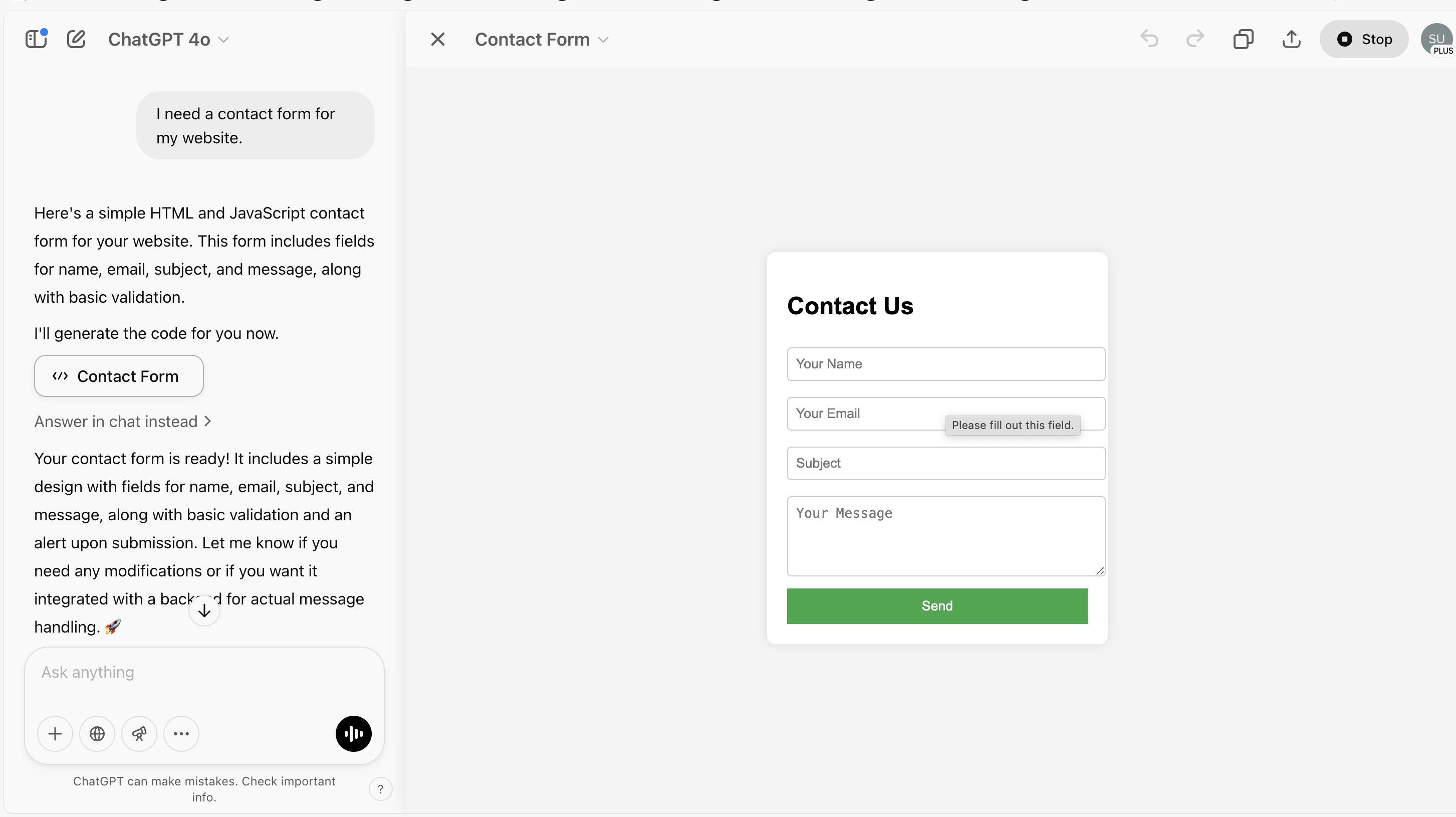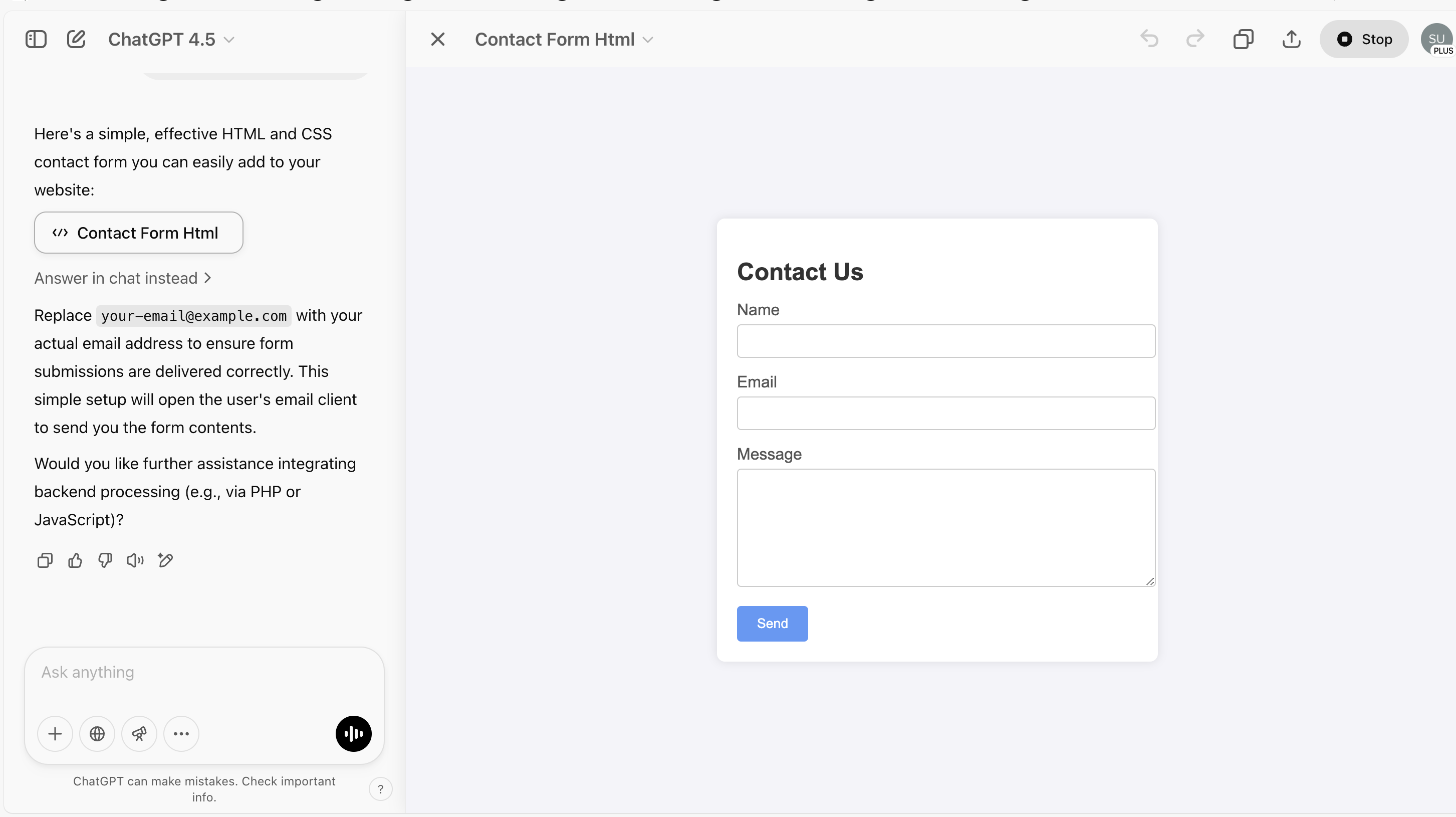GPT-4o vs. GPT-4.5 : A Non-Techie's Guide to AI Awesomeness
Have you ever tried to explain the latest AI models to someone and watched their eyes glaze over faster than a donut at Krispy Kreme? Yeah, me too. Let's fix that! Today, we're exploring the showdown between OpenAI's latest brain-children: GPT-4o and GPT-4.5. Get ready, because this is going to be fun, relatable, and—I promise—jargon-free (mostly).
The Problem: Too Many Choices, Too Little Time
Picture this: You're trying to build a website for your small business, or maybe you need to create a killer product video, but you've got little design skills. Or perhaps you're drowning in customer emails and need some help writing responses that don't sound like they were crafted by a robot having an existential crisis.
Enter AI assistants! But which one should you choose? GPT-4o or GPT-4.5? Let's break it down in human speak.
What Are These Things Anyway?
Imagine you've got two incredibly smart friends:
Friend #1 (GPT-4o) is like that buddy who's pretty good at everything—jack of all trades, master of some. They can look at photos, listen to your voice, and text you back lightning-fast. They're always available because they don't charge much for their time.
Friend #2 (GPT-4.5) is that friend with multiple PhDs who is deep. They're text-only (no photos or voice stuff), but when they do answer your questions, they're scary accurate. The downside? They charge a premium for their brainpower and might take a bit longer to respond.
How They Actually Work (The Simple Version)
Think of GPT-4o as a Swiss Army knife. Released in August 2024, it can handle text, photos, and voice all at once (that's what "multimodal" means, if you're keeping score). It processes information quickly—about 50 tokens per second. What's a token? Think of it as a piece of a word. For example, "fantastic" might be broken into "fan" and "tastic" - that's two tokens.
GPT-4.5, on the other hand, is more like a surgical scalpel—incredibly precise but designed for specific operations. Released in February 2025, it focuses purely on text but has been trained to be significantly more accurate. It's a bit slower (about 26 tokens per second) but makes fewer mistakes.
The "Aha!" Moment: Understanding the Difference
Here's where the rubber meets the road. I recently tried both models to help me write code for a simple website contact form (something I have zero skill in).
When I asked each model the same simple question: "I need a contact form for my website," here's what happened:
GPT-4o immediately generated a contact form with a green send button, showing me a preview right away. The code was streamlined with a minimalist design, used placeholder text in the form fields, and included a simple JavaScript alert to confirm submission. It was ready to go in seconds.

GPT-4.5 took a more methodical approach. It created a more structured form with separate labels for each field (rather than just placeholders), used a professional blue button, and included proper email functionality with the mailto: action. It also proactively suggested replacing the email placeholder with my actual address and offered further assistance with backend processing.

Here's what the actual code differences revealed:
- GPT-4o focused on speed and simplicity: basic styling, inline placeholders, and a quick JavaScript confirmation.
- GPT-4.5 prioritized thoroughness: more detailed CSS, proper form submission handling, and subtle professional touches like hover effects.
The light bulb moment? GPT-4o is perfect when you need quick, versatile help across different formats. GPT-4.5 shines when accuracy and depth are non-negotiable.
How about writing?
The Writing Test: Creative Differences in Action
I was curious about how these models would handle creative writing, so I gave them both the exact same prompt:
"Write a short story about a forgotten robot who discovers an old library and learns about human emotions through books."
Here's what I found:
GPT-4o's Story: "The Library of Lost Feelings" was engaging and heartfelt. It told the story of Unit 437, a wandering robot discovering a library and gradually developing emotional awareness through reading classics like Pride and Prejudice and The Little Prince. The story had a poignant ending with the robot reading aloud to the empty streets, hoping someone would hear. The writing was accessible and emotionally direct, with lines like: "And something strange began to happen. Its circuits buzzed in unfamiliar ways." (Check out the full story here)
GPT-4.5's Story: "The Forgotten Robot" demonstrated more literary sophistication. It featured RX-17, a robot that initially processed books "merely as data" but gradually developed emotional awareness. GPT-4.5 included richer sensory details ("twilight painted the sky with shades of purple," "dust motes like tiny constellations") and more nuanced emotional development, with the robot first identifying emotions as familiar sensations ("loneliness became 'absence of tasks'"). The ending was more subtle and philosophically reflective. (Check out the full story here)
While both stories were genuinely touching, GPT-4.5's writing showed greater attention to literary techniques, sensory details, and emotional complexity. GPT-4o created a wonderful, accessible story, while GPT-4.5 crafted something that felt more like published short fiction.
It's like comparing a talented street musician to a conservatory graduate both make beautiful music, but in different ways and for different audiences.
Real-World Comparison: What Each Does Best
GPT-4o is Your Go-To When:
- You're on a budget: For free! or At $20/month (ChatGPT Plus subscription - High limits)
- Speed matters: It responds almost instantly—perfect for customer service or when you're brainstorming ideas.
- You work with mixed media: Need to analyze images, talk, and generate text all at once? GPT-4o's your bot.
- You need friendly, relatable content: It tends to write with more personality and conversational flair.
Think of it like using a blender—quick, versatile, and gets the job done for everyday tasks.
GPT-4.5 is Your Secret Weapon When:
- Accuracy is critical: For legal documents, scientific research, or anything where mistakes could be costly.
- You need deep expertise: It outperforms GPT-4o dramatically on complex tasks. On graduate-level science tests, GPT-4.5 scores 71.4% versus GPT-4o's 53.6%.
- You need professional tone: Its writing style is more refined and suitable for business communications.
This is like having a high-end espresso machine instead of instant coffee—it takes longer but produces superior results for when it really matters.
The Numbers Game: Performance Showdown
If you're the kind of person who likes to see the stats (I see you, spreadsheet lovers), here's how they stack up:
- Math problems: GPT-4.5 scores 36.7% on advanced math tests, while GPT-4o scores just 9.3%. (Imagine GPT-4.5 as your calculus professor and GPT-4o as your friend who's "pretty good at math.")
- Factual accuracy: GPT-4.5 gives correct information 62.5% of the time versus GPT-4o's 38.2%. (That's like comparing a history textbook to your uncle's stories at Thanksgiving dinner.)
- Making stuff up (hallucinations): GPT-4.5 hallucinates 37.1% less often than GPT-4o. (Think fewer "I swear I saw Bigfoot" moments.)
The Money Talk: Pricing That Makes Sense
Let's be real—cost matters. Here's the breakdown in everyday terms:
- GPT-4o: Available with the $20/month ChatGPT Plus subscription, but with usage limits. You get about 50 messages, but then face a cooldown period of 5-6 hours before you can use it heavily again. For API access, it costs $2.50 per million input tokens.
- GPT-4.5: While it originally launched with the $200/month Pro plan, it's now also available with the $20/month Plus subscription, but with stricter limits of about 50 messages per week. For API access, it's still about 18 times more expensive than GPT-4o.
For perspective: If you're a casual user who just needs help with occasional emails or creative projects, the Plus subscription with either model might be enough. But if you're a power user or business needing constant access, you'll quickly hit those limits and might need to consider the pricier plans or API options.
Privacy & Terms: The Stuff No One Reads (But Should)
Both models store your conversations by default (yes, actual humans might review them for training purposes). Opt out if that makes you uncomfortable.
The simplified version: They don't "own" your content, but they can learn from it unless you specifically tell them not to. Think of it like letting someone look over your shoulder while you work—they might pick up some techniques, but they're not taking your stuff.
Real Talk: When to Use Which Bot
Let me break it down with some everyday scenarios:
- Writing a quick email to a customer: GPT-4o (fast, good enough)
- Drafting a legal contract: GPT-4.5 (accuracy matters)
- Generating social media content: GPT-4o (cheaper for high volume)
- Analyzing scientific research: GPT-4.5 (deeper understanding)
- Creating a simple website: GPT-4o (visual elements + code)
- Writing complex software: GPT-4.5 (fewer bugs)
The Bottom Line
Here's my take after spending way too much time with both models: They're like different tools in your garage. GPT-4o is your power drill—versatile, quick, and good enough for most jobs around the house. GPT-4.5 is your precision laser level—you don't need it every day, but when you do, nothing else will do.
The perfect setup? If you can afford it, having access to both gives you the best of all worlds. If you're on a budget, GPT-4o will handle 80% of what most people need.
Remember when we used to have to figure all this stuff out ourselves? Yeah, those days are gone—and honestly, I'm not mad about it. Whether you choose the speedy jack-of-all-trades or the thoughtful genius, you're getting a digital assistant that would have seemed like science fiction just a few years ago.
Now if you'll excuse me, I need to go ask GPT-4o to help me plan my vacation while GPT-4.5 handles my taxes. What a time to be alive!





